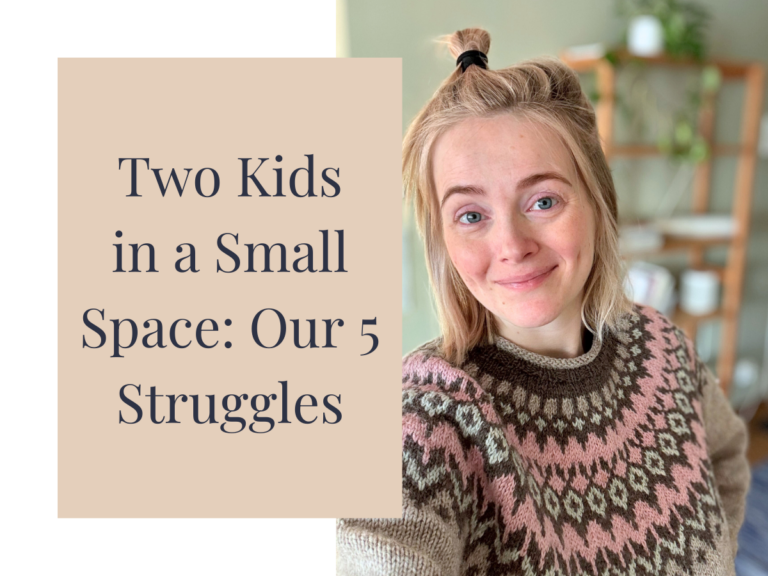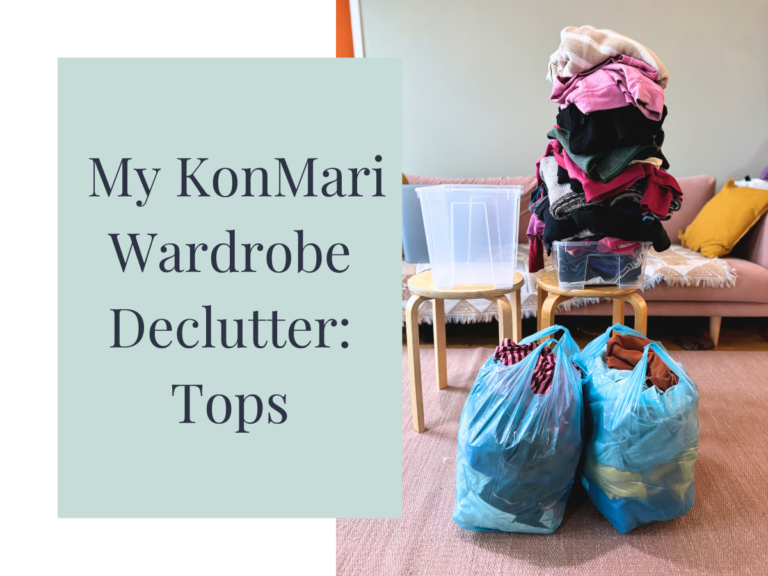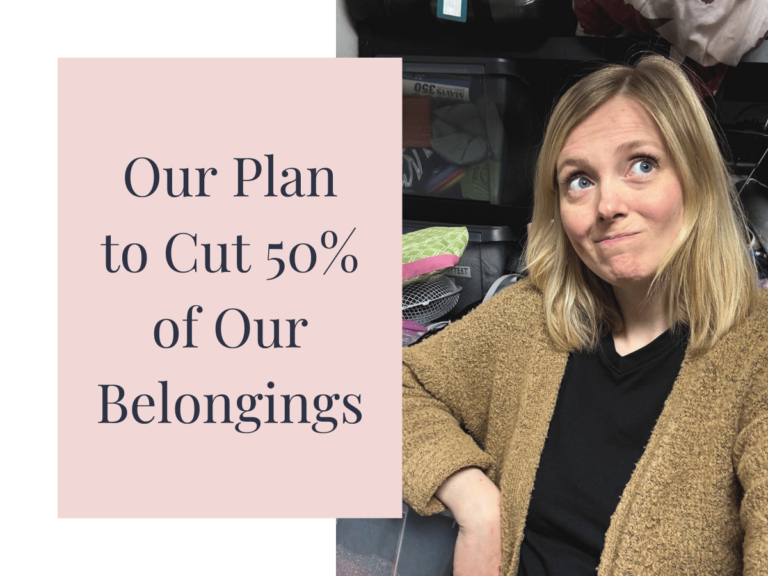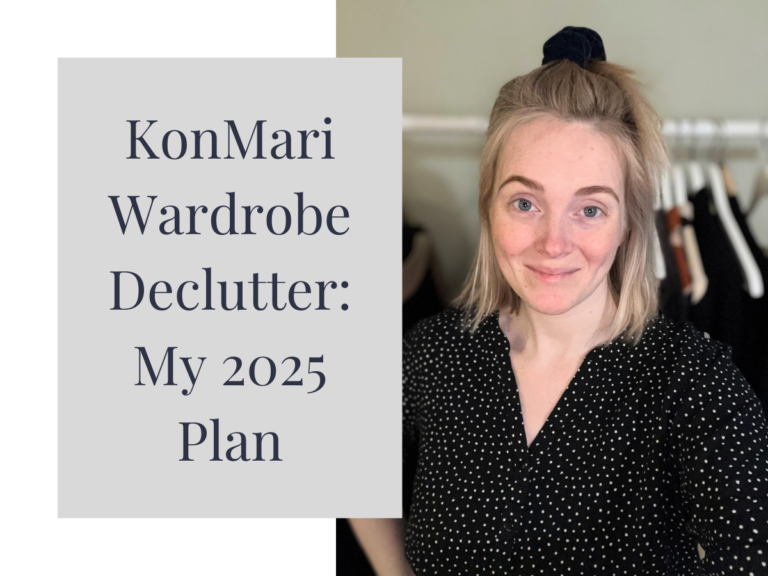KonMari Declutter Method: Why I Had to Break the Rules (to Stay Sane)
Our goal for 2025 is to reduce 50% of our family’s possessions using the KonMari declutter method.
In this blog post, I’ll share what happened as I started implementing the KonMari Method by collecting all my clothes into one spot.
I’ll explain how this quickly became a problem in our household and how I came up with a solution!
Why We’re Starting Our KonMari Decluttering Journey
We’re excited to simplify our home and routines—especially with a big change just around the corner. By the end of February (only a few weeks away!), we’ll be raising two kids under 2!
We’re not entirely sure if having less stuff will make a noticeable difference in our daily lives, but we’re hopeful.
There must be some truth to the idea that a home with less clutter creates more mental space.
Instead of constantly tidying or shuffling things around because something is always in the way, we might actually have the time and energy to focus on other things that are more important.
Plus, having fewer items means fewer choices to make. This could reduce decision fatigue significantly.
Another benefit we’re counting on is the mental clarity that comes from being surrounded by only the things we actually need. No more reminders of:
- Past versions of ourselves
- Hobbies we don’t have time for anymore
- Clothes that no longer fit
We believe this shift will have a positive impact on our mental health. At least, that’s the hope as we start our journey into family minimalism.
We’ll start by decluttering our home one category at a time.
What is the KonMari Method for Decluttering?
The Japanese decluttering expert Marie Kondo introduced the KonMari Method in her book The Life-Changing Magic of Tidying Up: The Japanese Art of Decluttering and Organizing (2011).
In the book, she describes the KonMari declutter method as a process of carefully going through all your possessions, one category at a time, and discarding any items that no longer bring joy to your life.
Why Start with Clothes According to the KonMari Method?
According to the KonMari Method, clothing is the first category you should tackle. That’s where I also decided to start.
Kondo emphasizes starting with your personal possessions rather than items belonging to other family members or children.
By focusing on your own belongings first and discarding anything that doesn’t spark joy, you can create a significant impact on yourself and build momentum to move through other categories, like shared household items.
Problem: Gathering All Clothes in One Place Resulted In a Mess
The first step of the KonMari declutter method is to “place every item of clothing in the house on the floor.”
When I started decluttering my clothes in early January, I followed Kondo’s advice, and started to gather all my clothes from around the house into one place.
Knowing our toddler’s endless energy, I didn’t follow this advice exactly. Piling everything on the floor would have been a disaster in our household! Instead, I used a clothing rack and storage containers to keep things more contained but still did my best to collect everything in one spot in our living room.
Why did this still become a problem?
We moved into our 2-bedroom apartment just over a year ago, not knowing we’d soon have two children in such a short time.
So, space is tight for us right now, and we’re in the process of figuring out our living situation. Our options are to try and make our 2-bedroom apartment work for us or find something better suited for a family of four.
In the meantime, even with my adjustments to the KonMari Method, a big decluttering project like this quickly took over our shared living space, and it didn’t go smoothly.
Our toddler kept stumbling and running into things and my husband and I both started becoming more and more irritated as days went by.
Solution: I Had to Break the Rules of the KonMari Declutter Method
Kondo advises never to start organizing your belongings before discarding the items that no longer spark joy.
The problem was that my clothes, now piled up in our living room for days, left the whole family feeling overwhelmed.
This was on top of our usual mess. The kind that naturally happens when you’re raising little ones who are curious about everything and love pulling things out of cupboards and drawers.
To make matters worse, I only had a few short moments each day to continue sorting through the items.
I realized I desperately needed a solution to reduce the tension and chaos caused by the growing mess.
This meant breaking one of the core rules of the KonMari Method: I had to start organizing and storing items before finishing the process of discarding.
A Possible Solution: Dividing Clothing Into Sub-Categories
Kondo suggests to break down the category of clothing into smaller sub-categories, to increase efficiency.
The sub-categories of clothing according to the KonMari declutter method are:
- Tops
- Bottoms
- Clothes that are better hung
- Socks
- Underwear
- Accessories
- Clothes for special events
- Shoes
While I did just that, believing this would help me divide the task of decluttering my clothes into smaller chunks, piles of clutter started forming around our shared living room.
And the problem was, I didn’t have time to sort through the items as fast as I would have hoped.
I quickly started feeling like I had fallen into a trap!
Our Storage Space Issue
Space is tight in our 2-bedroom home.
We only have one proper closet for storing clothes, located in the master bedroom.
However, we just exchanged bedrooms with our toddler so that she and (soon) the baby could have a bigger space to share. We moved into the smaller bedroom, which doesn’t have a closet.
The problem is that the built-in closet in the master bedroom couldn’t just move with us into the smaller bedroom.
As a result, all our clothes are currently “in-between homes,” waiting for a more permanent storage solution. In the meantime, they’ve been scattered across multiple places: separate bookcases, dressers, and clothing racks.
Meanwhile, the master bedroom closet has turned into a catch-all space for anything we’re not currently using.
This includes random items like candles, kids’ off-season shoes, office supplies that haven’t found a permanent home, and a messy collection of towels and linens.
Creating a Temporary Holding Zone for Clothes
To reduce the chaos in our home, I came up with a solution. I decided to create a holding zone for all my clothes.
This meant I had to pause my decluttering process and think carefully about where I could temporarily store everything.
I decided the master bedroom closet would serve as the holding zone.
To start, I emptied the entire closet. Then, I collected the subcategories of clothing that had been scattered across the living room and organized them into sections in the closet.
This pause required me to shift my focus from decluttering to finding a storage solution for my clothes.
Ironically, this is the opposite of what Kondo advises in her method, as it can slow down the discarding process!
However, now that our living room is finally free from the piles of clothing, I can actually continue decluttering with a clearer mind.
The closet will act as a temporary holding zone, allowing me to work through each clothing subcategory, one step at a time.
Lesson: Planning How to Store Things While Decluttering is Important
One thing I’ve learned so far is that methods designed for most people don’t always work for everyone.
Especially for families with small children.
Unless a method is specifically tailored to the realities of family life, it can be challenging to follow.
Then there’s the issue of space.
Not everyone has the luxury of a spare room to spread out a decluttering project and leave it untouched for days until everything is sorted.
Have You Broken or Modified the Rules of the KonMari Declutter Method?
I’d love to hear your stories and tips on how you’ve managed the challenge of keeping your living space organized while decluttering.
With a toddler, time is limited.
Projects like this take longer than they might for others who can focus fully on decluttering and get it done more quickly.
In our small space, we also have to ensure we clear things away for the night.
This is partly because of the space limitations, but also because our curious toddler tends to undo all the hard work I’ve done that day.
So, we had to come up with a solution for storing things temporarily before discarding them.




